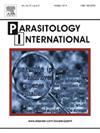In vivo efficacy of novel phosphoethanolamine methyltransferase inhibitors against Haemonchus contortus in a jird (Meriones unguiculatus) model
IF 1.9
4区 医学
Q3 PARASITOLOGY
引用次数: 0
Abstract
Anthelmintic resistance (AR) presents a significant challenge to the treatment of parasites in veterinary medicine, and is emerging as a growing concern in human medicine. Despite the pressing demand for compounds with novel mechanisms of action, the introduction of new anthelmintics to the market has been scarce. In this study, we investigated the in vivo efficacy of compounds previously demonstrated to be inhibitors of phosphoethanolamine methyltransferases (PMTs), enzymes that are highly conserved among parasitic nematodes and represent a novel drug target. Inhibition of PMT enzymes disrupts phosphocholine biosynthesis, which is crucial for parasite viability. This pathway is essential to nematodes and is not present in mammals, making it an attractive and highly selective drug target. Based on previous results obtained from in vitro screenings against both drug-susceptible and multidrug-resistant (MDR) Haemonchus contortus, three candidate compounds with potent in vitro activity were selected for use in a pilot in vivo study. Here, we employed the jird (Meriones unguiculatus) – H. contortus model. The dosing regimens used were selected based on available toxicological data, but since pharmacokinetic-pharmacodynamic (PKPD) profiles of these compounds are not known, dosing regimens were not optimized. As this was a pilot study, small groups of animals were used. Relatively high reductions in worm counts were achieved, ranging from 53.5 to 72.6 %, and for two of the three compounds this reduction was statistically significant (P = 0.008, P = 0.025). These findings further support PMT enzymes as viable drug targets in parasitic nematodes and highlight the need for PKPD studies. Optimizing dosing regimens and exploring synergistic activity could enhance efficacy, advancing the development of novel anthelmintics.

新型磷酸乙醇胺甲基转移酶抑制剂对弓形血蜱的体内抑制作用
驱虫药耐药(AR)对兽药寄生虫的治疗提出了重大挑战,并正在成为人类医学日益关注的问题。尽管迫切需要具有新的作用机制的化合物,但向市场引入新的驱虫剂一直很少。在这项研究中,我们研究了先前被证明是磷酸乙醇胺甲基转移酶(pmt)抑制剂的化合物的体内功效,pmt是寄生线虫中高度保守的酶,代表了一种新的药物靶点。抑制PMT酶会破坏磷脂胆碱的生物合成,这对寄生虫的生存至关重要。这种途径对线虫是必不可少的,而在哺乳动物中不存在,使其成为一个有吸引力和高度选择性的药物靶点。根据先前针对药物敏感和多重耐药(MDR)扭曲血蜱(Haemonchus扭曲)的体外筛选结果,选择了三种具有有效体外活性的候选化合物用于体内试验研究。在这里,我们采用第三(Meriones unguiculatus) - H. contortus模型。使用的给药方案是根据现有的毒理学数据选择的,但由于这些化合物的药代动力学-药效学(PKPD)谱尚不清楚,因此没有对给药方案进行优化。由于这是一项初步研究,所以只使用了一小群动物。蠕虫数量的减少相对较高,从53.5%到72.6%不等,三种化合物中的两种减少具有统计学意义(P = 0.008, P = 0.025)。这些发现进一步支持了PMT酶作为寄生线虫可行的药物靶点,并强调了PKPD研究的必要性。优化给药方案,探索协同作用,可提高药效,促进新型驱虫药的开发。
本文章由计算机程序翻译,如有差异,请以英文原文为准。
求助全文
约1分钟内获得全文
求助全文
来源期刊

Parasitology International
医学-寄生虫学
CiteScore
4.00
自引率
10.50%
发文量
140
审稿时长
61 days
期刊介绍:
Parasitology International provides a medium for rapid, carefully reviewed publications in the field of human and animal parasitology. Original papers, rapid communications, and original case reports from all geographical areas and covering all parasitological disciplines, including structure, immunology, cell biology, biochemistry, molecular biology, and systematics, may be submitted. Reviews on recent developments are invited regularly, but suggestions in this respect are welcome. Letters to the Editor commenting on any aspect of the Journal are also welcome.
 求助内容:
求助内容: 应助结果提醒方式:
应助结果提醒方式:


